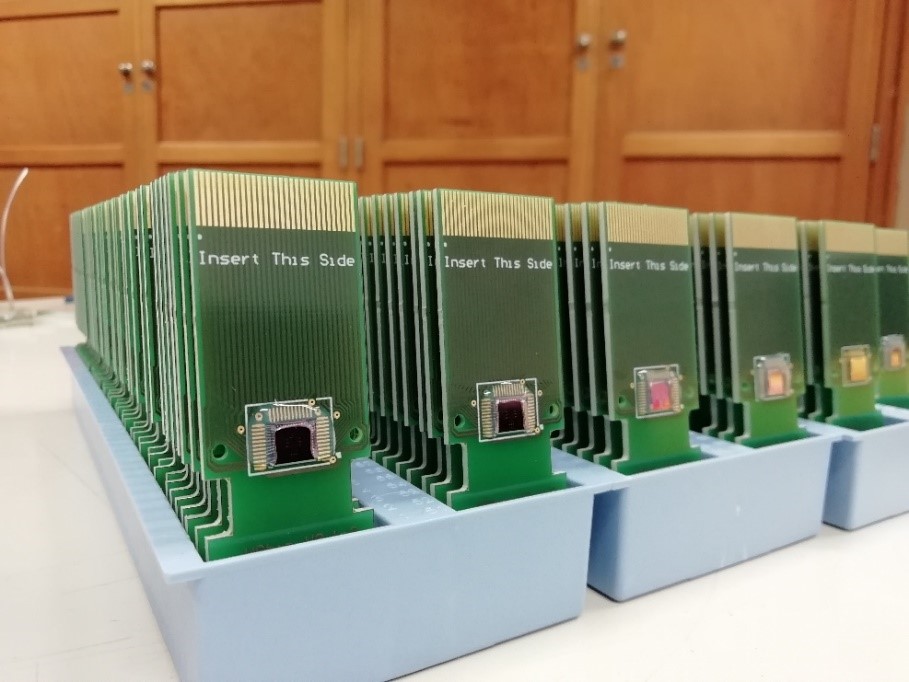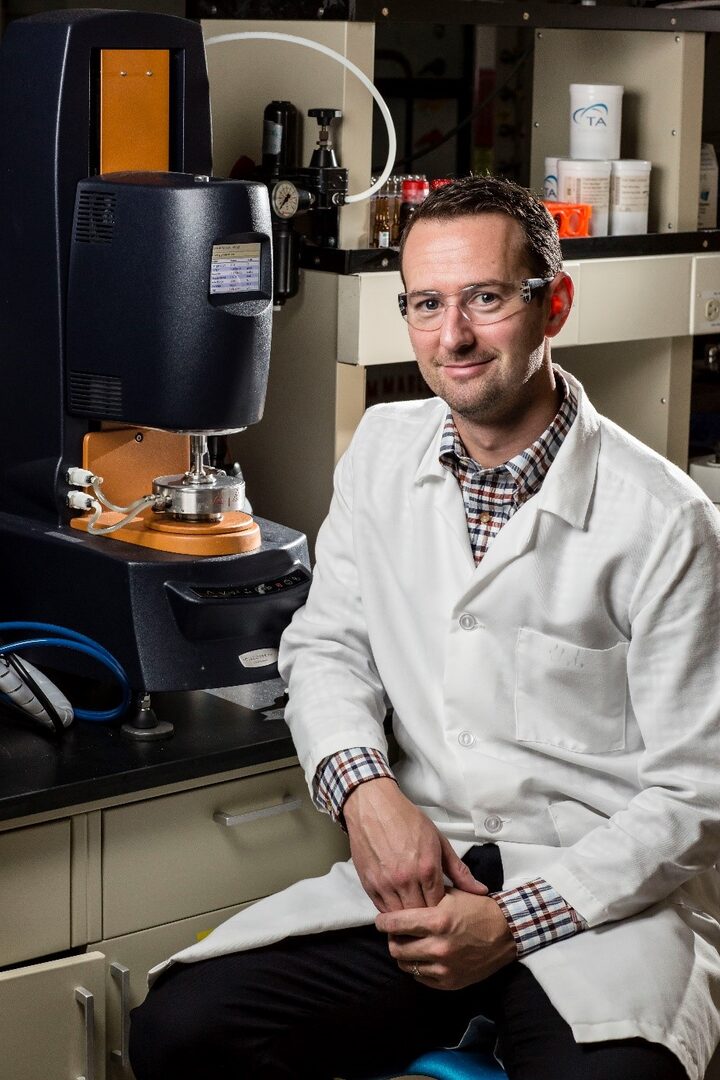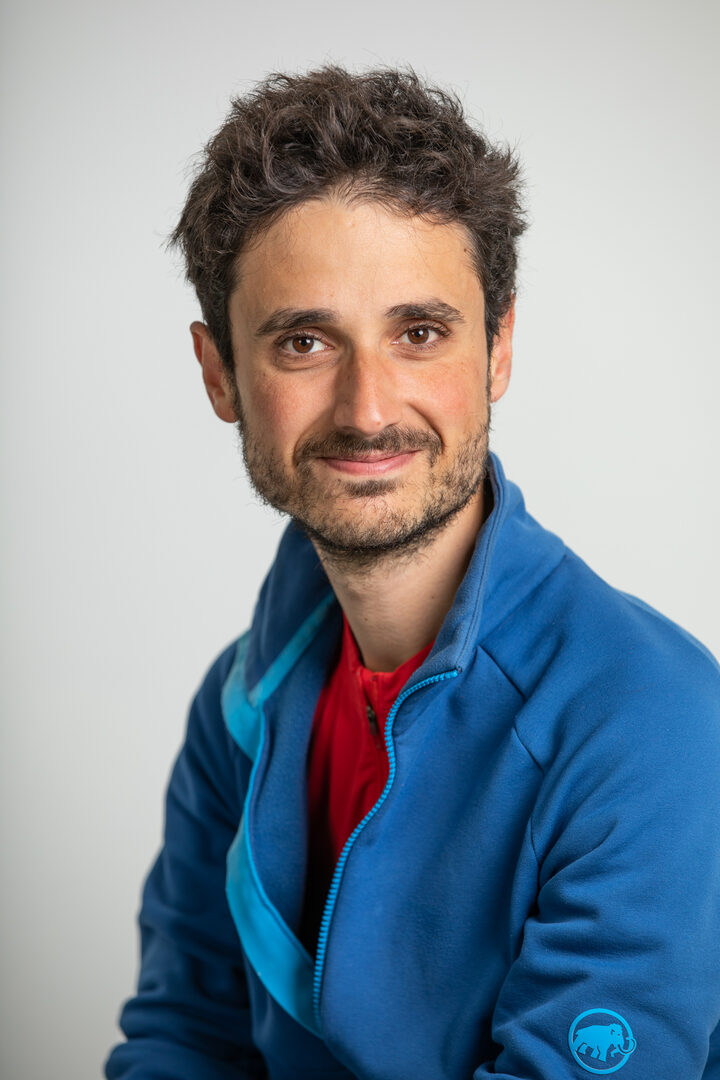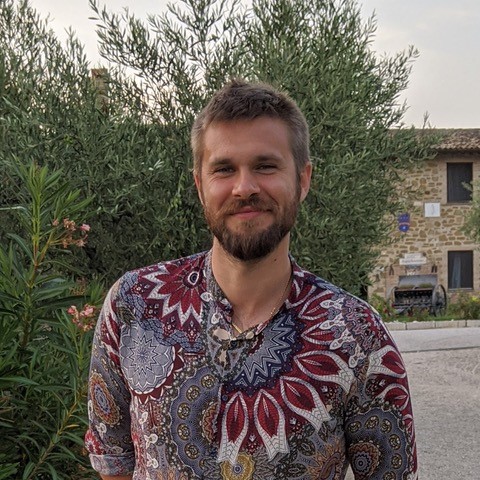FY2021 Annual Report
Micro/Bio/Nanofluidcs Unit
Professor Amy Shen
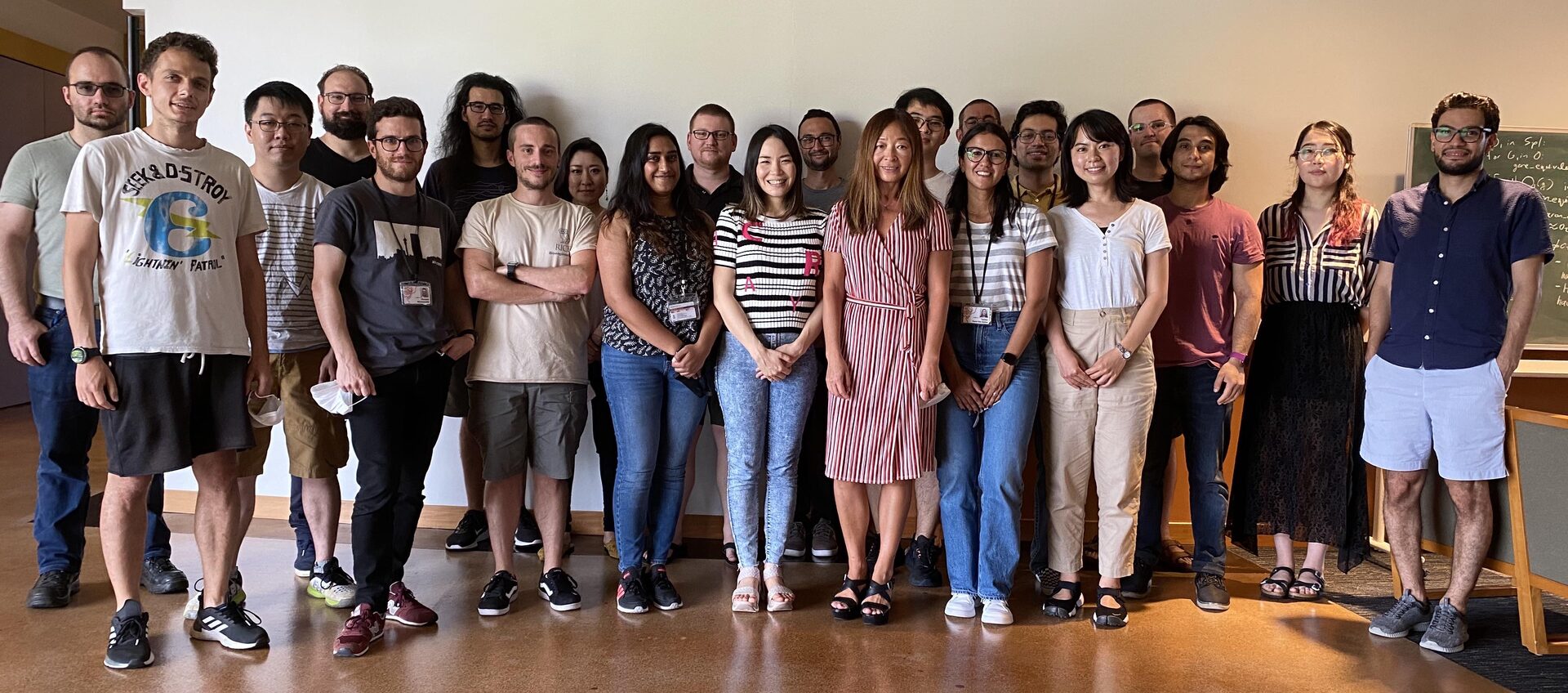
Abstract
Our unit members have been working hard with their research projects and local outreach activities during FY2021. We published 19 peer-reviewed papers total, with our research highlighted in Physics Today, Science Daily, News Nine, Bioengineer News, etc. The unit members have also actively disseminated our research results to the general public and scientific communities. We gave more than 20 invited and contributed presentations and seminars in FY2021, participated virtual professional society meetings such as 2021 Annual European Rheology conference, 2021 International Congress of Theoretical and Applied Mechanics, 20th International Workshop on Numerical Methods for Non-Newtonian Flows in 2021, European Colloid & Interface Society (ECIS) 2021, 2022 British Society of rheology (BSR), etc. Due to the pandemic, we hosted 16 zoom seminars by internationally renowned scientists, with topics ranging from microfluidics, rheology, and biotechnology.
Many unit members have received very prestigious fellowships and Kakenhi grants in FY2021. Vincenzo Calabrese was awarded Kakenhi (Grant-in-Aid for Early-Career Scientists) on his project titled "Colloidal-rods for examining polymer dynamics in complex flows". Stelios was awarded Kakenhi (Grant-in-Aid for Early-Career Scientists) on his project titled "Interaction of non-Newtonian fluids with deformable structures in microscale biological processes". Shivani became the OIST Technology Pioneer Fellow for technology transfer.
Personnel wise, both Charlotte and Vikram took new positions in Europe in late 2021. Paul established his startup company (Ryudyn Co.) and joined the Biomedical Engineering Department at Chang Gung University in Taiwan as an Assistant Professor in January 2022. In September 2021, we welcomed Dr. Tatiana Porto Dos Santos from University of Campinas in Brazil and Dr. Vincenzo Mazzaracchio from University of Rome "Tor Vergata" in Italy. In March 2022, we welcomed Dr. Ricardo Arturo Lopez de la Cruz from University of Twente. Our unit also hosted 2 Ph.D rotation students from OIST and 2 research interns from Osaka University and Kyushu University in Japan.
1. Group Member
As of March 31, 2022
• Prof. Amy Shen, Professor
• Dr. Simon Haward, Group Leader
• Dr. Cameron Hopkins, Postdoctoral Scholar
• Dr. Daniel Carlson, Postdoctoral Scholar
• Dr. Vincenzo Calabrese, Postdoctoral Scholar
• Dr. Stylianos Varchanis, Postdoctoral Scholar
• Dr. Shivani Sathish, (OIST POC Fellow)
• Dr. Tatiana Porto Dos Santos, Postdoctoral Scholar
• Dr. Vincenzo Mazzaracchio, Postdoctoral Scholar
• Dr. Ricardo Arturo Lopez de la Cruz, Postdoctoral Scholar
• Mr. Kazumi Toda-Peters, Technician
• Mr. San To Chan, Graduate Student
• Ms. Ainash Garifullina, Graduate Student
• Ms. Hiromu Josha, Research Administrator
Alumni
• Dr. Vikram Rathee, Postdoctoral Scholar
• Dr. Charlotte de Blois, Postdoctoral Scholar
• Dr. Hsieh-Fu Tsai, Founder of Ryudyn Co. and now Assistant Professor at Chang Gung University
• Mr. Patrick Clark, Graduate Student (Rotation)
• Mr. Tomoya Noma, Graduate Student (Rotation)
• Ms. Arisa Yokokoji, Research Intern (Osaka University)
• Ms. Haruna Takahashi, Research Intern (Kyushu University)
2. Collaborations
Joint Research
• Professor John Tsamopoulos, University of Patras, Greece
• Professor Patrick Anderson, Eindhoven University of Technology, The Netherlands
• Professor Frank Scheffold, University of Fribourg, Switzerland
• Dr. Riccardo Funari, University of Bari, Italy
• Professor Giovanniantonio Natale, University of Calgary, Canada
• Professor Tadashi Inoue, University of Osaka, Japan
• Professor Atsushi Matsumoto, University of Fukui, Japan
• Professor Simone Pigolotti, OIST
• Professor Marco Rosti, OIST
3. Activities and Findings
3.1 Bifurcation, instability, and flow alignment of complex fluids
3.1.1 Stagnation points control chaotic fluctuations in viscoelastic porous media flow
Simon J. Haward, Cameron C. Hopkins and Amy Q. Shen, PNAS, 118: e2111651118 (2021).
Viscoelastic flows through porous media become unstable and chaotic beyond critical flow conditions, impacting widespread industrial and biological processes such as enhanced oil recovery and drug delivery. Understanding the influence of the pore structure or geometry on the onset of flow instability can lead to fundamental insights into these processes and, potentially, to their optimization. Recently, for viscoelastic flows through porous media modeled by arrays of microscopic posts, Walkama et al. [D. M. Walkama, N. Waisbord, J. S. Guasto, Phys. Rev. Lett. 124, 164501 (2020)] demonstrated that geometric disorder greatly suppressed the strength of the chaotic fluctuations that arose as the flow rate was increased. However, in that work, disorder was only applied to one originally ordered configuration of posts. Here, we demonstrate experimentally that, given a slightly modified ordered array of posts, introducing disorder can also promote chaotic fluctuations. We provide a unifying explanation for these contrasting results by considering the effect of disorder on the occurrence of stagnation points exposed to the flow field, which depends on the nature of the originally ordered post array. This work provides a general understanding of how pore geometry affects the stability of viscoelastic porous media flows.
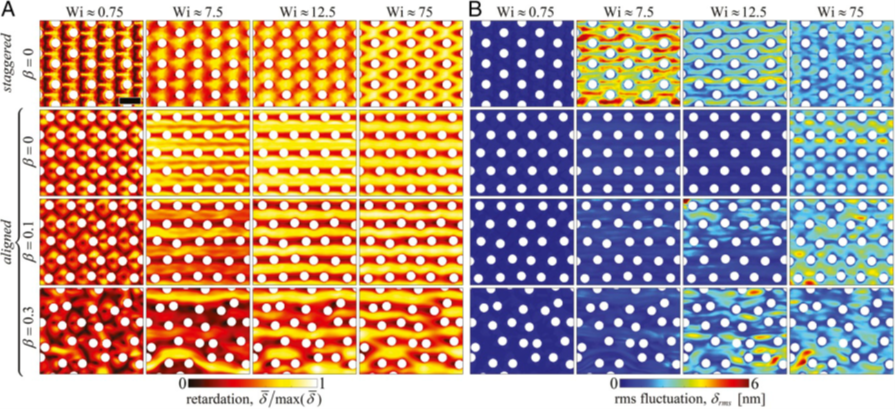
Fig. 1: Evolution of retardation fields with increasing Wi (i.e., flow rate) for a viscoelastic wormlike micellar solution in the ordered staggered post array and in aligned arrays with increasing disorder β: (A) normalized, time-averaged retardation fields δ/max(δ) and (B) local retardation fluctuations rms. Flow is from left to right and the field of view is centered at the coordinate origin at the center of each array (54% of full field of view shown). (Scale bar: 250 μm). For an initially aligned array, it is seen that introducing disorder tends to enhance the chaotic fluctuations. This contrasts with the results of Walkama et al. for introducing disorder to a staggered array.
3.1.2 Bifurcations in flows of complex fluids around microfluidic cylinders
Bifurcations in flows of complex fluids around microfluidic cylinders, Simon J. Haward, Cameron C. Hopkins, Stylianos Varchanis, Amy Q. Shen, Lab on a Chip, 21, 4041-4059 (2021).
Flow around a cylinder is a classical problem in fluid dynamics and also one of the benchmarks for testing viscoelastic flows. The problem is of wide relevance to understanding many microscale industrial and biological processes and applications, such as porous media and mucociliary flows. In recent years, we have developed model microfluidic geometries consisting of very slender cylinders fabricated in glass by selective laser-induced etching. The cylinder radius is small compared with the channel width, which allows the effects of the stagnation points in the flow to dominate over the effects of squeezing between the cylinder and the channel walls. Furthermore, the cylinders are contained in high aspect ratio microchannels that render the flow field approximately two-dimensional (2D) and therefore conveniently permit comparison between experiments and 2D numerical simulations. A number of different viscoelastic fluids including wormlike micellar and various polymer solutions have been tested in our devices. Of particular interest to us has been the occurrence of a striking, steady-in-time, flow asymmetry that occurs for certain non-Newtonian fluids when the dimensionless Weissenberg number (quantifying the importance of elastic over viscous forces in the flow) increases above a critical value. In this perspective review, we present a summary of our key findings related to this novel flow instability and present our current understanding of the mechanism for its onset and growth. We believe that the same fundamental mechanism may also underlie some important non-Newtonian phenomena observed in viscoelastic flows around particles, drops, and bubbles, or through geometries composed of multiple bifurcation points such as cylinder arrays and other porous media. Knowledge of the instability we discuss will be important to consider in the design of optimally functional lab-on-a-chip devices in which viscoelastic fluids are to be used.
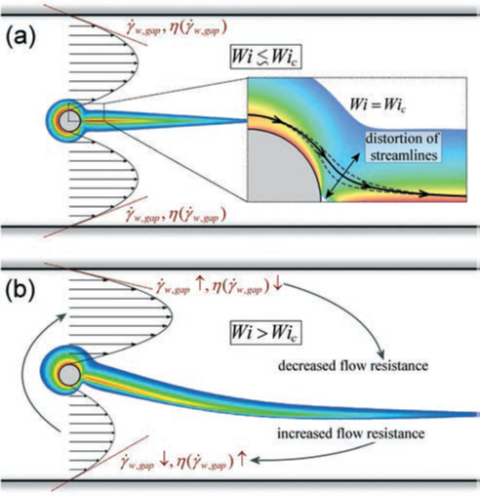
Fig. 2: Schematic illustration of the instability mechanism for asymmetric flows of shear-thinning elastic fluids around cylinders. Coloured regions are indicative of the FIB measured in experiments, or the principle stress difference obtained from numerical simulations. (a) Symmetric flow at Wi ≲ Wic and (inset) perturbation of symmetric flow due to the onset of elastic instability at Wi = Wic. (b) Situation in the asymmetric flow state where a positive feedback loop (indicated by grey arrowed lines) leads to growth of the instability for Wi > Wic.
3.1.3 Structure-property relationship of a soft colloidal glass in simple and mixed flows
Vincenzo Calabrese, Stylianos Varchanis, Simon J. Haward, John Tsamopoulos, Amy Q. Shen, Journal of Colloid and Interface science, 601, 454-466, (2021).
Under specific conditions, rod-like cellulose nanocrystals (CNC) can assemble into structurally ordered soft glasses (SGs) with anisotropy that can be controlled by applying shear. However, to achieve full structural control of SGs in real industrial processes, their response to mixed shear and extensional kinematics needs to be determined. We use an aqueous suspension with 2 wt% CNC at 25 mM NaCl to form a structurally ordered SG composed of a CNC network containing nematic domains. We combine rheometry and microfluidic experiments with numerical simulations to study the flow properties of the SG in shear, extension, and mixed flow conditions. Extensional flow is investigated in the Optimised Shape Cross-slot Extensional Rheometer (OSCER), where the SG is exposed to shear-free planar elongation. Mixed flow kinematics are investigated in a benchmark microfluidic cylinder device (MCD) where the SG flows past a confined cylinder in a microchannel. The SG in the MCD displays a velocity overshoot (negative wake) and a pronounced CNC alignment downstream of the cylinder. Simulations using the thixotropic elasto-visco-plastic (TEVP) model yield near quantitative agreement of the velocity profiles in simple and mixed flows and capture the structural fingerprint of the material. Our results provide a comprehensive link between the structural behaviour of a CNC-based SG and its mechanistic properties, laying foundations for the development of functional, built-to-order soft materials.

Fig. 3: (Left) Soft glass (SG) composed on rod-like cellulose nanocrystals (CNC) between crossed polarizers and white light. (Right) Experiment and simulation of the SG flowing in a microfluidic cylinder device (MCD).
3.1.4 Microtomographic PIV of viscoelastic instabilities in a 3D microcontraction
Daniel W. Carlson, Amy. Q. Shen and Simon J. Haward, Journal of Fluid Mechanics, 923, R6. (2021).
Viscoelastic flow through an abrupt planar contraction geometry above a certain Weissenberg number (Wi) is well known to become unstable upstream of the contraction plane via a central jet separating from the walls and forming vortices in the salient corners. Here, for the first time we consider three-dimensional (3D) viscoelastic contraction flows in a microfabricated glass square-square contraction geometry. We employ state-of-the-art microtomographic particle image velocimetry to produce time-resolved and volumetric quantification of the 3D viscoelastic instabilities arising in a dilute polymer solution driven through the geometry over a wide range of Wi but at negligible Reynolds number. Based on our observations, we describe new insights into the growth, propagation, and transient dynamics of an elastic vortex formed upstream of the 3D micro-contraction due to flow jetting towards the contraction. At low Wi we observe vortex growth for increasing Wi, followed by a previously unreported vortex growth plateau region. In the plateau region, the vortex circulates around the jet with a period that decreases with Wi but an amplitude that is independent of Wi. In addition, we report new out-of-plane asymmetric jetting behaviour with a phase-wise dependence on Wi. Finally, we resolve the rate-of-strain tensor D and ascribe local gradients in D as the underlying driver of circulation via strain-hardening of the fluid in the wake of the jet.
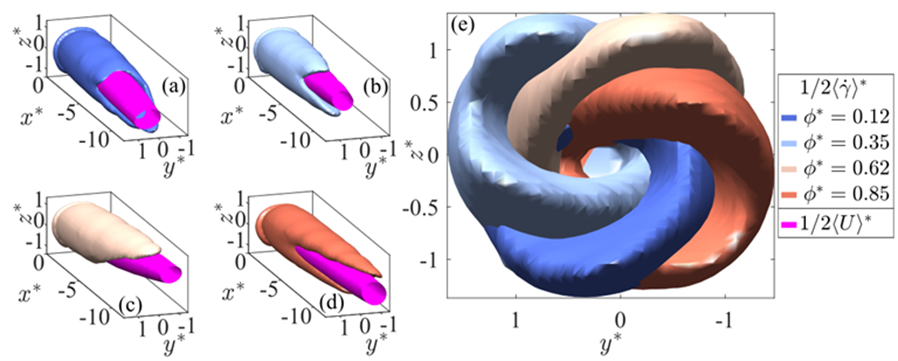
Fig. 4: (a-d) Phase-averaged isosurfaces for Wi = 87, with the contraction at x* = 0. (e) The x* projection from (a-d), coloured by their normalized phase time φ*. For advancing time φ*, the inner jet displaces towards decreasing rate-of-strain.
3.1.5 Torsional instability of viscoelastic liquid bridges
(A) Torsional fracture of viscoelastic liquid bridges
San To Chan, Frank P. A. van Berlo, Hammad A. Faizi, Atsushi Matsumoto, Simon J. Haward, Patrick D. Anderson, and Amy Q. Shen, Torsional fracture of viscoelastic liquid bridges, PNAS, 118 (24), e2104790118, (2021).
Short liquid bridges are stable under the action of surface tension. In applications like electronic packaging, food engineering, and additive manufacturing, this poses challenges to the clean and fast dispensing of viscoelastic fluids. Here, we investigate how viscoelastic liquid bridges can be destabilized by torsion. By combining high-speed imaging and numerical simulation, we show that concave surfaces of liquid bridges can localize shear, in turn localizing normal stresses and making the surface more concave. Such positive feedback creates an indent, which propagates toward the center and leads to breakup of the liquid bridge. The indent formation mechanism closely resembles edge fracture, an often undesired viscoelastic flow instability characterized by the sudden indentation of the fluid’s free surface when the fluid is subjected to shear. By applying torsion, even short, capillary stable liquid bridges can be broken in the order of 1 s. This may lead to the development of dispensing protocols that reduce substrate contamination by the satellite droplets and long capillary tails formed by capillary retraction, which is the current mainstream industrial method for destabilizing viscoelastic liquid bridges.
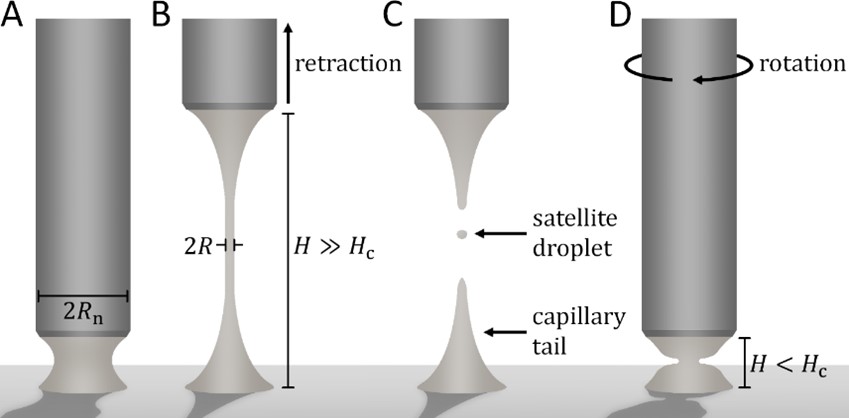
Fig. 5: A typical dispensing process. (A) A liquid bridge of height H connecting the nozzle of radius Rn and the substrate. (B) Retracting the nozzle to a height H >> Hc above the critical height Hc destabilizes the liquid bridge and causes it to thin under surface tension. (C) For viscoelastic liquid bridges, nozzle retraction creates satellite droplets and a long capillary tail, which may contaminate the substrate. (D) By applying torsion to a stable viscoelastic liquid bridge, an indent propagates toward the bridge center, leading to breakup even at H < Hc.
(B) Torsional instability of constant viscosity elastic liquid bridges
San To Chan, Stylianos Varchanis, Simon J Haward, Amy Q Shen, Torsional instability of constant viscosity elastic liquid bridges, Soft Matter, 18, 1965-1977, (2022).
By experiment and simulation, we report that viscoelastic liquid bridges made of constant viscosity elastic liquids, a.k.a. Boger fluids, can be effectively destabilized by torsion. Under torsion, the deformation of the liquid bridge depends on the competition between elastocapillarity and torsion-induced normal stress effects. When the elastocapillary effect dominates, the liquid bridge undergoes elastocapillary instability and thins into a cylindrical thread, whose length increases and whose radius decays exponentially over time. When the torsion-induced normal stress effect dominates, the liquid bridge deforms in a way similar to edge fracture, a flow instability characterized by the sudden indentation of the fluid's free surface when a viscoelastic fluid is sheared at above a critical deformation rate. The vertical component of the normal stress causes the upper and lower portions of the liquid bridge to approach each other, and the radial component of the normal stress results in the liquid bridge thinning more quickly than under elastocapillarity. Whether such quick thinning continues until the bridge breaks depends on both the liquid bridge configuration and the level of torsion applied.
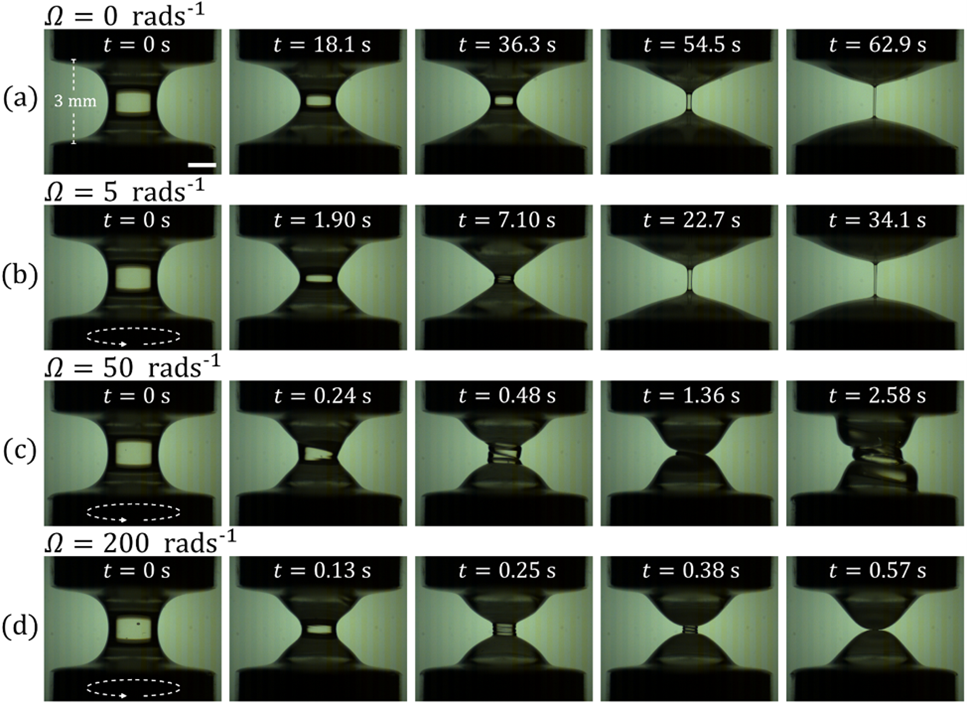
Fig. 6: Snapshots of the viscoelastic liquid bridge of H = 3 mm subjected to different rotational speeds Ω captured at different times t. (a) Ω = 0 rad s−1. (b) Ω = 5 rad s−1. (c) Ω = 50 rad s−1. (d) Ω = 200 rad s−1. Scale-bar: 1 mm.
3.1.6 Origin of the sharkskin instability
Stylianos Varchanis, Dionisis Pettas, Yannis Dimakopoulos, John Tsamopoulos, Origin of the Sharkskin Instability: Nonlinear Dynamics, Physical Review Letters, 127, 088001, (2021).
The appearance of surface distortions on polymer melt extrudates, often referred to as sharkskin instability, is a long-standing problem. We report results of a simple physical model, which link the inception of surface defects with intense stretch of polymer chains and subsequent recoil at the region where the melt detaches from the solid wall of the die. The transition from smooth to wavy extrudate is attributed to a Hopf bifurcation, followed by a sequence of period doubling bifurcations, which eventually lead to elastic turbulence under creeping flow. The predicted flow profiles exhibit all the characteristics of the experimentally observed surface defects during polymer melt extrusion.

Fig. 7: Tension in the flow as the melt extrudes near the edge of the slit stretches the polymer chains. When the polymer chains recoil, they can create the flow instability that is responsible for the sharkskin texture.
3.1.7 Emulsions inside microfluidics
Tatiana Porto Santos, Cesare M. Cejas, and Rosiane Lopes Cunha, Microfluidics as a tool to assess and induce emulsion destabilization, Soft Matter, 18, 698 (2022).
Microfluidics can be used as an efficient tool to assess emulsion stability and to observe the behavior of the droplets immediately after their formation, enabling to determine whether or not they are prone to re-coalescence. Observation of the droplets after emulsifier adsorption also allows the investigation of emulsion stability over time. Both evaluations would contribute to determine emulsion stability aiming at specific applications in food and pharmaceutical industries. This work reviews different microfluidic techniques (such as changing channel geometry or wettability) hitherto used to destabilize emulsions, whether the droplets are destabilized in confined or dynamic flow processes.
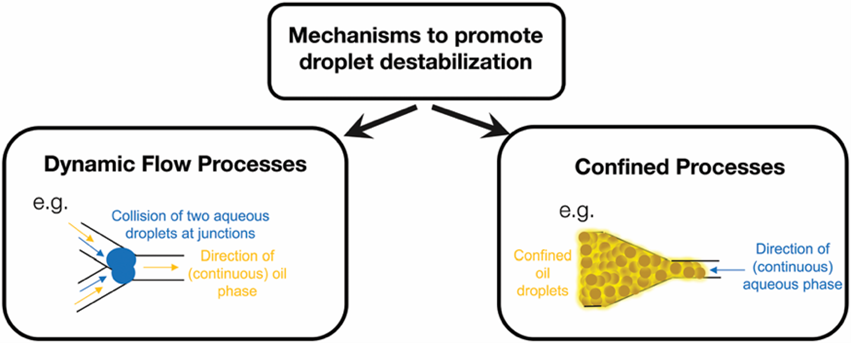
Fig. 8: Schematic examples of mechanisms promoting emulsion destabilization.
3.2 Rheology and interfacial science of different complex fluid systems
3.2.1 Entanglement Properties of Polyelectrolyte Solutions
Atsushi Matsumoto, Chi Zhang, Frank Scheffold, Amy Q. Shen, Microrheological approach for probing the entanglement properties of polyelectrolyte solutions, ACS Macro Letters, 11, 84-90, (2022).
The entanglement dynamics and viscoelasticity of polyelectrolyte solutions remain active research topics. Previous studies have reported conflicting experimental results when compared to Dobrynin’s scaling predictions derived from the Doi–Edwards (DE) tube model for entangled polymers. By combining classical bulk shear rheometry with diffusing wave spectroscopy (DWS) microrheometry, we investigate how the key viscoelastic parameters (the specific viscosity ηsp, the plateau modulus Ge, and the ratio of the reptation time to the Rouse time of an entanglement strand τrep/τe) depend on the polymer concentration for semidilute entangled (SE) solutions containing poly(sodium styrenesulfonate) with high molecular weight. Our experimental measurements yield Ge ∝ c1.51±0.04, in good agreement with the scaling of Ge ∝ c1.5 predicted by Dobrynin’s model for salt-free polyelectrolyte SE solutions, suggesting that the electrostatic interaction influences the viscoelastic properties of polyelectrolyte SE solutions. On the other hand, the deviation in the scaling exponent for ηsp ∝ c2.56±0.04 and τrep/τe ∝ c1.82±0.28 is observed between our DWS experiments and Dobrynin’s model prediction (∝ c1.5), likely due to the fact that Dobrynin’s scaling model does not account for mechanisms such as the contour length fluctuation, the constraint release, and the retardation of solvent dynamics, which are known to occur for SE solutions of neutral polymers.
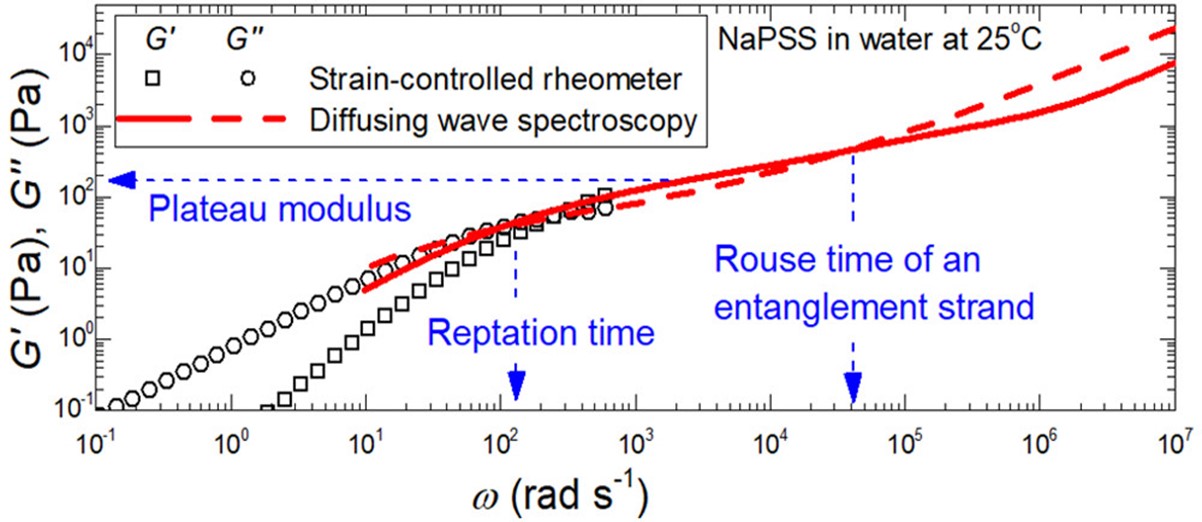
Fig. 9: The scaling relationships obtained with both bulk rheology and DWS microrheology provide new insights to the long-standing debate on the entanglement dynamics of polyelectrolyte solutions.
3.2.2 Rheological Scaling of Ionic Liquid-Based Polyelectrolytes in the Semidilute Unentangled Regime
Atsushi Matsumoto, Ryota Yoshizawa, Osamu Urakawa, Tadashi Inoue, Amy Q. Shen, Rheological Scaling of Ionic Liquid-Based Polyelectrolytes in the Semidilute Unentangled Regime from Low to High Salt Concentrations, Macomolecules, 54, 12, 5648–5661, (2021).
Polymerized ionic liquids (PILs) are a special class of ion-containing polymers with ionic liquid structures. The viscoelastic properties of PILs in IL solutions are expected to be influenced by both polymer–polymer interaction and charge screening by IL ions, which becomes complex at high IL concentrations due to strong ionic correlations. In this work, we aim to understand the effect of the ionic correlations on the shear rheology of PIL in IL solutions in the semidilute unentangled (SU) polymer regime, with moderate polymer–polymer interactions. We conducted systematic rheological characterization of a PIL, poly(1-butyl-3-vinylimidazolium bis(trifluoromethanesulfonyl)imide), in a mixture of an IL, 1-butyl-3-methylimidazolium bis(trifluoromethanesulfonyl)imide, and a non-ionic solvent, dimethylformamide, to evaluate the specific viscosity ηsp and the longest relaxation time λ with varying IL concentrations cIL, at a fixed polymer concentration. We found that both ηsp and λ initially decreased with the increasing cIL, following the scaling theory of polyelectrolyte solutions in the low salt concentration regime. However, these values exhibited an upturn at high cIL. We explained the observed non-monotonic viscoelastic behavior by proposing a charge screening model for SU solutions, accounting for both modified screening length in concentrated IL solutions and complete charge screening.
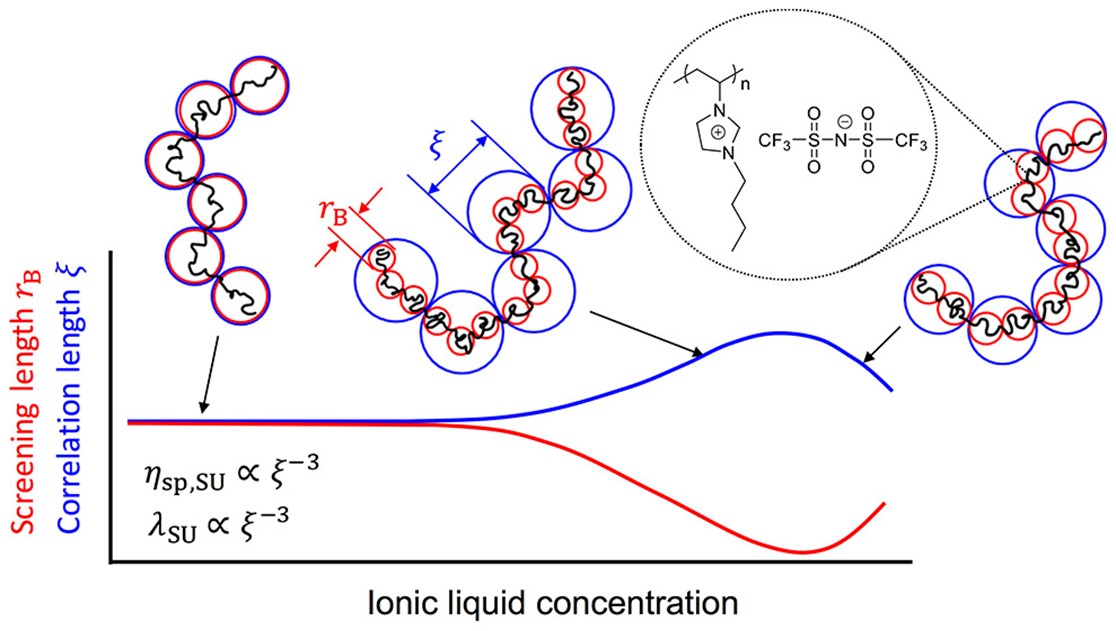
Fig. 10: The strong ionic correlation in concentrated IL solutions modifies the electrostatics of PILs and their corresponding viscoelastic properties in the presence of moderate polymer–polymer interactions.
3.2.3 Shear thickening behavior in dense repulsive and attractive suspensions
Vikram Rathee, Alessandro Monti, Marco E. Rosti, and Amy Q. Shen, Shear thickening behavior in dense repulsive and attractive suspensions of hard spheres, Soft Matter, 17, 8047-8058, (2021); Alessandro Monti, Vikram Rathee, Amy Q. Shen, and Marco E. Rosti, A fast and efficient tool to study the rheology of dense suspensions, Physics of Fluids, 33, 103314 (2021).
Shear thickening in stable dense colloidal suspensions is a reversible phenomenon and no hysteresis is observed in the flow curve measurements. However, a reduction in the stability of colloids promotes particle aggregation and introduces a time dependent rheological response. In this work, by using a model colloidal system of hard spherical silica particles (average diameter of 415 nm) with varying particle volume fractions 0.2 ≤ ϕ ≤ 0.56, we study the effect of particle stability on the hysteresis of the shear thickening behavior of these suspensions. The particle stability is manipulated by adding a simple monovalent salt (sodium chloride) in the silica suspension with varying concentrations α ∈ [0,0.5] M. For repulsive and weakly attractive suspensions, the flow behavior is history independent and the shear thickening behavior does not exhibit hysteresis. However, significant hysteresis is observed in rheological measurements for strongly attractive suspensions, with shear history playing a critical role due to the dynamic nature of particle clusters, resulting in time dependent hysteresis behavior. By performing numerical simulations, we find that this hysteresis behavior arises due to the competition among shear, electrostatic repulsive, van der Waals attractive, and frictional contact forces. The critical shear stress (i.e., the onset of shear thickening) decreases with increasing salt concentrations, which can be captured by a scaling relationship based on the force balance between particle–particle contact force and electrostatic repulsive force.
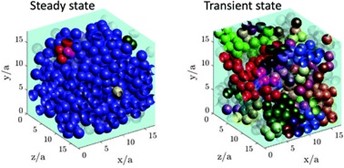
3.2.4 Reduced and increased flow resistance in shear-dominated flows of Oldroyd-B fluids
Stylianos Varchanis, John Tsamopoulos, Amy Q. Shen, Simon J. Haward, Reduced and increased flow resistance in shear-dominated flows of Oldroyd-B fluids, Journal of Non-Newtonian Fluid Mechanics, 300, 104698, (2022).
We present a comprehensive analytical and numerical study of shear-dominated flows of Oldroyd-B fluids. Starting from transient ideal Couette flow, we show that less work is required to increase the shear rate than to decrease it. Generalizing this observation to non-homogeneous steady flows, we show that reduced flow resistance is present around streamlines with increasing shear rate and increased flow resistance is present around streamlines with decreasing shear rate. We demonstrate this effect in smoothly converging or diverging Couette and Poiseuille flows. Finally, we show that the reduced flow resistance observed in the flow past a cylinder in a straight channel is caused by the contraction-expansion-like flow that takes place at the sides of the cylinder. Our findings are validated by a wide parametric analysis regarding the geometrical characteristics of the flow domains and the material parameters of the Oldroyd-B model.
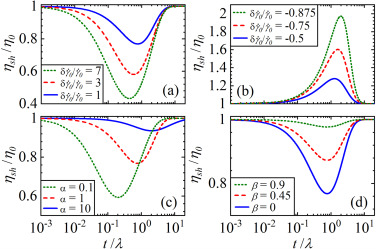
Fig. 11: Shear-thinning and shear-thickening effects during the startup Couette flow of an Oldroyd-B fluid.
3.3 Biophysics and biotechnology at the nano-bio-interface
Our unit has been developing various sensor platforms whereas nanofabrication, surface chemistry, and device integration are equally important to achieve superior biosensing performance. Our unit also has a fruitful collaboration with Professor Simone Pigolotti's group at OIST to study population genetics using microfluidics.
3.3.1 Developing rapid, specific, and sensitive microfluidic sensors
Shivani Sathish and Amy Q. Shen, Toward the development of rapid, specific, and sensitive microfluidic sensors: a comprehensive device blueprint, JACS Au, 1, 11, 1815–1833, (2021).
Recent advances in nano/microfluidics have led to the miniaturization of surface-based chemical and biochemical sensors, with applications ranging from environmental monitoring to disease diagnostics. These systems rely on the detection of analytes flowing in a liquid sample, by exploiting their innate nature to react with specific receptors immobilized on the microchannel walls. The efficiency of these systems is defined by the cumulative effect of analyte detection speed, sensitivity, and specificity. In this work, we provide a fresh outlook on the use of important parameters obtained from well-characterized analytical models, by connecting the mass transport and reaction limits with the experimentally attainable limits of analyte detection efficiency. We breakdown when and how the operational (e.g., flow rates, channel geometries, mode of detection, etc.) and molecular (e.g., receptor affinity and functionality) variables can be tailored to enhance the analyte detection time, analytical specificity, and sensitivity of the system (i.e., limit of detection).

Fig. 12: A blueprint for the development of high-efficiency surface-based microfluidic sensors for rapid, sensitive, and specific detection of chemical and biochemical analytes.
3.3.2 High aspect ratio Ag/AI plasmonic nanopillars for biomarker detection
Ainash Garifullina and Amy Q. Shen, High-throughput fabrication of high aspect ratio Ag/Al nanopillars for optical detection of biomarkers, Journal of Materials Chemistry B, 9, 8851-8861, (2021).
Nanomaterials-based optical techniques for biomarker detection have garnered tremendous attention from the nanofabrication community due to their high precision and enhanced limits of detection (LoD) features. These nanomaterials are highly responsive to local refractive index (RI) fluctuations, and their RI unit sensitivity can be tuned by varying chemical composition, geometry, and dimensions of the utilized nanostructures. We report for the first time a fast, high-throughput, and cheap nanofabrication protocol for routine manufacturing of polymer-based nanostructures with high sensitivity and calculated LoD in the pM range by utilizing anodized aluminum oxide (AAO) membranes as templates. Specifically, our developed platform consists of arrays of nearly uniform polystyrene nanopillars with average diameter of ~ 185 nm and aspect ratio of ~ 11.2. We demonstrate that our nanostructures can be produced at a high speed and a notably low price and that they can be efficiently applied for biosensing purposes after being coated with aluminum-doped silver (Ag/Al) thin films. Our platform successfully detected very low concentrations of human C-reactive protein (hCRP) and SARS-CoV-2 spike protein biomarkers in human plasma samples with LoD of 11 and 5 pM, respectively.
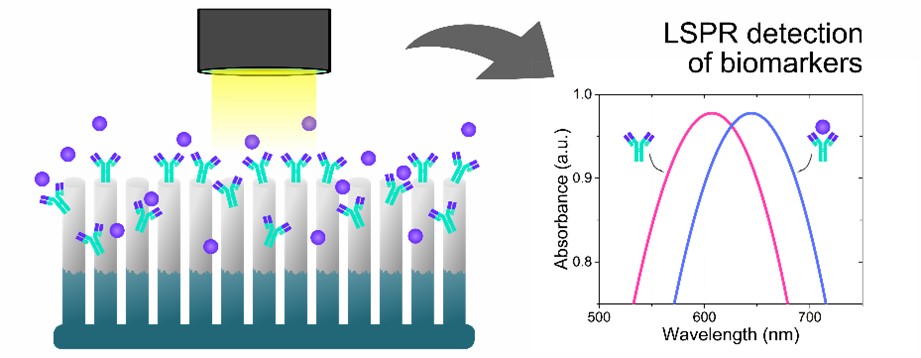
Fig. 13: Schematic of LSPR detection using high aspect ratio plasmonic nanopillars. Our approach can be used as a base for nanoplasmonic sensors with competitive LoD values.
3.3.3 Detection and Characterization of Bacterial Biofilms and Biofilm-Based Sensors
Riccardo Funari, Amy Q. Shen, Detection and Characterization of Bacterial Biofilms and Biofilm-Based Sensors, ACS Sensors,7, 2, 347–357, (2022).
Microbial biofilms have caused serious concerns in healthcare, medical, and food industries because of their intrinsic resistance against conventional antibiotics and cleaning procedures and their capability to firmly adhere on surfaces for persistent contamination. These global issues strongly motivate researchers to develop novel methodologies to investigate the kinetics underlying biofilm formation, to understand the response of the biofilm with different chemical and physical treatments, and to identify biofilm-specific drugs with high-throughput screenings. Meanwhile microbial biofilms can also be utilized positively as sensing elements in cell-based sensors due to their strong adhesion on surfaces. In this perspective, we provide an overview on the connections between sensing and microbial biofilms, focusing on tools used to investigate biofilm properties, kinetics, and their response to chemicals or physical agents, and biofilm-based sensors, a type of biosensor using the bacterial biofilm as a biorecognition element to capture the presence of the target of interest by measuring the metabolic activity of the immobilized microbial cells. Finally we discuss possible new research directions for the development of robust and rapid biofilm related sensors with high temporal and spatial resolutions, pertinent to a wide range of applications.
Fig. 14: Synergy of sensor and biofilm research.
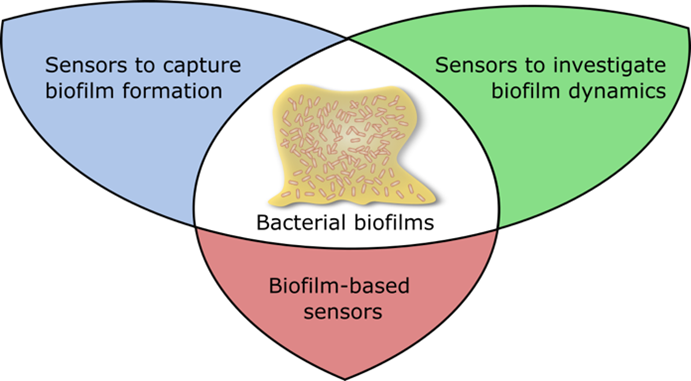
3.3.4 Study population genetics of bacteria using microfluidics
(a) Anzhelika Koldaeva, Hsieh-Fu Tsai, Amy Q. Shen, Simone Pigolotti, Population genetics in microchannels, PNAS, 110, e2120821110, (2022); (b) Hsieh-Fu Tsai, Daniel W. Carlson, Anzhelika Koldaeva, Simone Pigolotti, Amy Q. Shen, Optimization and fabrication of multi-level microchannels for long-term imaging of bacterial growth and expansion, Micromachines, 13(4), 576, (2022).
Many microbial populations proliferate in small channels. In such environments, reproducing cells organize in parallel lanes. Reproducing cells shift these lanes, potentially expelling other cells from the channel. In this paper, we combine theory and experiments to understand how these dynamics affects the diversity of a microbial population. We theoretically predict that genetic diversity is quickly lost along lanes of cells. Our experiments confirm that a population of proliferating Escherichia coli in a microchannel organizes into lanes of genetically identical cells within a few generations. Our findings elucidate the effect of lane formation on populations evolution, with potential applications ranging from microbial ecology in soil to dynamics of epithelial tissues in higher organisms.

Fig. 15: Competition between two E. coli strains (in red and green) in microchannels with two open ends.
4. Publications
4.1 Journals
- Anzhelika Koldaeva, Hsieh-Fu Tsai, Amy Q. Shen, Simone Pigolotti, Population genetics in microchannels, PNAS, 110, e2120821110, (2022). OPEN ACCESS
- San To Chan, Stylianos Varchanis, Simon J Haward, Amy Q Shen, Torsional instability of constant viscosity elastic liquid bridges, Soft Matter, 18, 1965-1977, (2022). OPEN ACCESS
- Atsushi Matsumoto, Chi Zhang, Frank Scheffold, Amy Q. Shen, Microrheological approach for probing the entanglement properties of polyelectrolyte solutions, ACS Macro Letters, 11, 84-90, (2022). OPEN ACCESS
- Stylianos Varchanis, John Tsamopoulos, Amy Q. Shen, Simon J. Haward, Reduced and increased flow resistance in shear-dominated flows of Oldroyd-B fluids, Journal of Non-Newtonian Fluid Mechanics, 300, 104698, (2022). OPEN ACCESS
- Hsieh-Fu Tsai, Daniel W. Carlson, Anzhelika Koldaeva, Simone Pigolotti, Amy Q. Shen, Optimization and fabrication of multi-level microchannels for long-term imaging of bacterial growth and expansion, Micromachines, 13(4), 576, (2022). OPEN ACCESS
- Riccardo Funari, Amy Q. Shen, Detection and Characterization of Bacterial Biofilms and Biofilm-Based Sensors, ACS Sensors, 7, 2, 347-357, (2022). OPEN ACCESS
- Simon J. Haward, Cameron C. Hopkins, and Amy Q. Shen, Stagnation points control chaotic fluctuations in viscoelastic porous media flow, PNAS, 118 (38), e211165118, (2021). OPEN ACCESS
- Simon J. Haward, Cameron C. Hopkins, Stylianos Varchanis, and Amy Q. Shen, Bifurcations in flows of complex fluids around microfluidic cylinders, Lab on a Chip, 21, 4041-4059, (2021). OPEN ACCESS
- Stylianos Varchanis, Dionisis Pettas, Yannis Dimakopoulos, and John Tsamopoulos, Origin of the Sharkskin Instability: Nonlinear Dynamics, Physical Review Letters, 127, 088001, (2021). OPEN ACCESS
- Daniel W Carlson, Amy Q Shen, Simon J Haward, Microtomographic PIV measurements of viscoelastic instabilities in a 3D micro-contraction, JFM Rapids, 923, R6, (2021). OPEN ACCESS
- Vikram Rathee, Alessandro Monti, Marco E. Rosti, and Amy Q. Shen, Shear thickening behavior in dense repulsive and attractive suspensions of hard spheres, Soft Matter, 17, 8047-8058, (2021). OPEN ACCESS
- Alessandro Monti, Vikram Rathee, Amy Q. Shen, and Marco E. Rosti, A fast and efficient tool to study the rheology of dense suspensions, Physics of Fluids, 33, 103314, (2021). OPEN ACCESS
- San To Chan, Frank P. A. van Berlo, Hammad A. Faizi, Atsushi Matsumoto, Simon J. Haward, Patrick D. Anderson, and Amy Q. Shen, Torsional fracture of viscoelastic liquid bridges, PNAS, 118 (24), e2104790118, (2021). OPEN ACCESS
- Vincenzo Calabrese, Deniz Z.Gunes, Isabel Fernández Farrés., Rheological control of pea fibre dispersions in oil: The role of particle and water volume fractions, Food Hydrocolloids, 121, 106988, (2021). LINK
- Razie Khalesi Moghaddam, Nikhil Bhalla, Amy Q Shen, Giovanniantonio Natale, Deterministic Particle Assembly on Nanophotonic Chips, Journal of Colloid and Interface Science, 603, 259-268, (2021). LINK
- Vincenzo Calabrese, Stylianos Varchanis, Simon J. Haward, John Tsamopoulos, Amy Q. Shen, Structure-property relationship of a soft colloidal glass in simple and mixed flows, Journal of Colloid and Interface Science, Feature Article, 601, 454-466, 2021. OPEN ACCESS
- Atsushi Matsumoto, Ryota Yoshizawa, Osamu Urakawa, Tadashi Inoue, Amy Q. Shen, Rheological Scaling of Ionic Liquid-Based Polyelectrolytes in the Semidilute Unentangled Regime from Low to High Salt Concentrations, Macomolecules, 54, 12, 5648–5661, 2021. OPEN ACCESS
- Shivani Sathish and Amy Q. Shen, Toward the development of rapid, specific, and sensitive microfluidic sensors: a comprehensive device blueprint, JACS Au, 1, 11, 1815–1833, (2021). OPEN ACCESS
- Ainash Garifullina and Amy Q. Shen, High-throughput fabrication of high aspect ratio Ag/Al nanopillars for optical detection of biomarkers, Journal of Materials Chemistry B, 9, 8851-8861, (2021). OPEN ACCESS
4.2 Books and other one-time publications
Nothing to report
4.3 Oral and Poster Presentations
- Cameron C. Hopkins, Simon J. Haward and Amy Q. Shen, Tristability in viscoelastic flow past side-by-side microcylinders, The Annual European Rheology Conference (Virtual), April 2021.
- Stylianos Varchanis, Cameron C. Hopkins, Amy Q. Shen, John Tsamopoulos, Simon J. Haward, Asymmetric flows of complex fluids past a cylinder in a microchannel, The Annual European Rheology Conference (Virtual), April 2021.
- San To Chan, Frank P.A. van Berlo, Hammad A. Faizi, Atsushi Matsumoto, Simon J. Haward, Patrick D. Anderson, Amy Q. Shen, Edge fracture instability of viscoelastic liquid bridges, The Annual European Rheology Conference (Virtual), April 2021.
- Daniel W. Carlson, Amy Q. Shen, Simon J. Haward, Tomographic PIV measurements of viscoelastic instabilities in a glass 3D micro-contraction, The Annual European Rheology Conference (Virtual), April 2021.
- Vincenzo Calabrese, Amy Q. Shen, Simon J. Haward, Effects of Shearing and Extensional Flows on the Alignment of Colloidal Rods, The Annual European Rheology Conference (Virtual), April 2021.
- Noa Burshtein, Arash Alizad Banaei, Simon J. Haward, Amy Q. Shen, Luca Brandt, Anke Lindner, Transport dynamics of micro particles in vortex flows, The Annual European Rheology Conference (Virtual), April 2021.
- Atsushi Matsumoto, Ryota Yoshizawa, Osamu Urakawa, Tadashi Inoue, Amy Q. Shen, Rheological Scaling of Ionic Liquid-Based Polyelectrolytes in Ionic Liquid Solutions, The Annual European Rheology Conference (Virtual), April 2021.
- Stylianos Varchanis and J. Tsamopoulos, “Numerical simulations of elastic and interfacial instabilities”, JNNFM Complex Fluids Seminar Series, April 2021.
- Stylianos Varchanis, Amy Q. Shen, Simon J. Haward, Shear-banded flows and elastic instabilities of wormlike micellar solutions in microfluidic devices, 20th International Workshop on Numerical Methods for Non-Newtonian Flows (Virtual), June 2021.
- Amy Q. Shen, Shivani Sathish, Development of rapid and sensitive biochemical sensors: enhanced local analyte replenishment in microfluidic receptor-analyte reaction systems, IUPAC World Chemistry Congress (Virtual), July 2021.
- Amy Q. Shen, Nano- and micro-fabrication enabled lab-on-a-chip platforms for biotechnology applications and beyond. The University of Tokyo and OIST Joint talk series for future science, July 2021.
- Cameron C. Hopkins, Simon J. Haward and Amy Q. Shen, Flow-induced vibrations due to the flow of a viscoelastic fluid between two cantilevered microcylinders, International Congress of Theoretical and Applied Mechanics (Virtual), August 2021.
- Vincenzo Calabrese, Amy Q. Shen, Simon J. Haward, Effects of Shearing and Extensional Flows on the Alignment of Colloidal Rods, European Colloid & Interface Society (ECIS), September 2021.
- Vincenzo Calabrese, Simon J. Haward, Amy Q. Shen, Microfluidic shearing and extensional flows on the alignment of cellulose nanocrystals, 19th Optics of Liquid Crystals (OLC2021), September 2021.
- Arisa Yokokoji, Taashi Inoue, Atsushi Matsumoto, Simon J. Haward, Amy Q. Shen, Extensional rheology of semidilute entangled solutions of polyelectrolytes in a cross-slot microchannel, Japanese Society of Rheology Meeting, October 2021.
- Atsushi Matsumoto, Ryota Yoshizawa, Osamu Urakawa, Tadashi Inoue, and Amy Q. Shen, Charge Screening Effects on the Rheology of Polymerized Ionic Liquid Solutions in the Semidilute Unentangled Regime, Society of Rheology Meeting, October 2021.
- Atsushi Matsumoto, Chi Zhang, Frank Scheffold, Amy Q. Shen, Microrheological Approach for Probing the Entanglement Properties of Polyelectrolyte Solutions, POLYSOLVAT-13 (13th International IUPAC Conference on Polymer-Solvent Complexes & Intercalates), November 2021.
- Amy Q. Shen, Simon J. Haward, Cameron Hopkins, Noa Burshtein, Viscoelastic instabilities in microfluidic flows, ISMIP10, The 10th International Symposium on Mixing in Industrial Processes, December 2021.
- Amy Q. Shen, Fluid viscoelasticity drives assembling particle trains in a straight microfluidic channel, PACIFICHEM 2021, 2021 International Chemical Congress, December 2021.
- Vincenzo Calabrese, Stylianos Varchanis, Simon J. Haward , John Tsamopoulos, Amy Q. Shen, Structure-property relationship of a soft colloidal glass in simple and mixed flows, British Society of rheology (BSR) (Virtual), January 2022.
5. Intellectual Property Rights and Other Specific Achievements
5. 1 Patents:
- Doojin Lee, Amy Q. Shen, Microheater integrated temperature controllable microfluidic tensiometer for measuring dynamic interfacial tension, US Patent 11,009,440, May 2021
- Paul Tsai, Amy Q. Shen, System and methods for object imaging, real-time analysis, and phenotypic prediction in a modular microscope embodiment with internet interactivity, Provisional, 63/287,005, December 2021.
- Nikhil Bhalla, Kang-Yu Chu, Amy Q. Shen, Nanoplasmonic instrumentation, materials, methods and system integration, US Patent, 11,293920B2, April 2022.
5. 2 Grants and Fellowships
- Simon Haward (PI), April 2021--March 2024, ¥3,900,000; Grant-in-Aid for Scientific Research (C); 21K03884, 3D microfluidics for extensional rheometry.
- Daniel Carlson (PI), April 2021--March 2023, ¥4,550,000; Grant-in-Aid for Early-Career Scientists; 21K14080, Micro-tomographic measurements of elastic turbulence,
- Vikram Rathee (PI), April 2021--March 2023, ¥3,640,000; Grant-in-Aid for Early-Career Scientists; 21K13895, Pressure driven Flow of dense suspensions in confinement.
- Amy Shen (PI), October 2021--September 2023, ¥25.3 M; Motif foodworks, USA, Flow induced gelation of protein solutions.
6. Meetings and Events
6.1 Virtual Seminars
1. Dr. Verónica C. Martins (INESC Microsistemas e Nanotecnologias, Lisbon, Portugal)
- Date: April 8, 2021
- Time: 9:00-10:00am
- Seminar title: Biosensors for the point-of-care diagnostics
- Website: https://sites.google.com/site/inescmn/people/vernica-martins
2. Dr. Simon Rogers
- Date: April 19, 2021
- Time: 9:00-10:00
- Seminar details: A material’s perspective: Developing a transient framework for understanding nonlinear rheological responses
- Website: https://chbe.illinois.edu/directory/profile/sarogers/
3. Prof. Gaetano Scamarcio
- Date: May 10, 2021
- Time: 16:00-17:00
- Seminar details: Bio-functionalized interfaces for molecule detection at the physical limit
- Website: https://www.uniba.it/docenti/scamarcio-gaetano
4. Prof. Vivek Sharma
- Date: July 19, 2021
- Time: 9:00-10:00
- Seminar details: Stretched Polymer Physics, Extensional Rheology and Free Surface Flows
- Website: https://che.uic.edu/profiles/vivek-sharma/
5. Dr. Bavand Keshavarz
- Date: Aug 16, 2021
- Time: 09:00-10:00
- Seminar details: Time–connectivity superposition and the gel/glass duality of weak colloidal gels
- Website: http://web.mit.edu/bavand/www/
6. Prof. Chandi Sasmal
- Date: Aug 30, 2021
- Time: 15:00-16:00
- Seminar details: Elastic instabilities and bifurcations in flows of wormlike micellar solutions: a numerical perspective with two-species constitutive model for wormlike micelles
- Website: https://sites.google.com/view/chandisasmal/home?authuser=0
6. Prof. Jacinta C. Conrad
- Date: Sep 6, 2021
- Time: 09:00-10:00
- Seminar details: Transport of nanoparticles in polymer solutions
- Website: http://conradlab.chee.uh.edu
7. Dr. Olivier Mesdjian
- Date: Oct 25, 2021
- Time: 16:00-17:00
- Seminar details: Longitudinal to transverse metachronal wave transitions in an in-vitro model of ciliated bronchial epithelium
- Website: https://www.cinam.univ-mrs.fr/cinam/en/team/physique-et-nano-micro-ingenierie-pour-le-vivant/
8. Prof. Arezoo Ardekani
- Date: Nov 1, 2021
- Time: 09:00-10:00
- Seminar details: Viscoelastic fluids through porous media: flow instability and particle transport
- Website: https://engineering.purdue.edu/ComplexFlowLab/
9. Dr. Antonio Minopoli
- Date: Nov 2, 2021
- Time: 16:30-17:30
- Seminar details: Plasmonic nanostructures for optical biosensing
10. Ricardo López
- Date: Nov 18, 2021
- Time: 16:00-17:00
- Seminar details: Marangoni effect and phase separation of mixtures within a Hele-Shaw cell
11. Prof. Chao Sun
- Date: Jan 12, 2022
- Time: 16:00-17:00
- Seminar details: Explosive boiling of drops near a solid surface and inside a turbulent flow
- Website: https://www.cce.tsinghua.edu.cn/info/1005/2118.htm
12. Dr. Davide Michieletto
- Date: Jan 24, 2022
- Time: 17:00-18:00
- Seminar details: Topologically Active Polymers
- Website: https://www2.ph.ed.ac.uk/~dmichiel/
13. Assistant Prof. Andrew Gibbons
- Date: Feb 7, 2022
- Time: 15:30-16:30
- Seminar details: Printing Porosity in Thin Film Polymers
- Website: https://pureosity.org/en/are-you-pureous/
14. Prof. Gareth H. McKinley
- Date: Feb 25, 2022
- Time: 10:00-11:00
- Seminar details: Gaborheometry: Applications of the Gabor Transform to Time-Resolved Oscillatory Rheometry
- Website: https://meche.mit.edu/people/faculty/GARETH@MIT.EDU
15. Dr. Cesare M. Cejas
- Date: Mar 7, 2022
- Time: 17:00-18:30
- Seminar details: Universal diagram for the kinetics of particle deposition in microchannels
- Website: https://www.microfluidx.co.uk/
16. Prof. Yogesh M Joshi
- Date: Mar 22, 2022
- Time: 16:00-17:00
- Seminar details: Analysis of Thixotropy
- Website: http://home.iitk.ac.in/~joshi/
7. Others
7.1 OIST Events
7.1.1 OIST Science Challenge workshop (Virtual Lab tour)
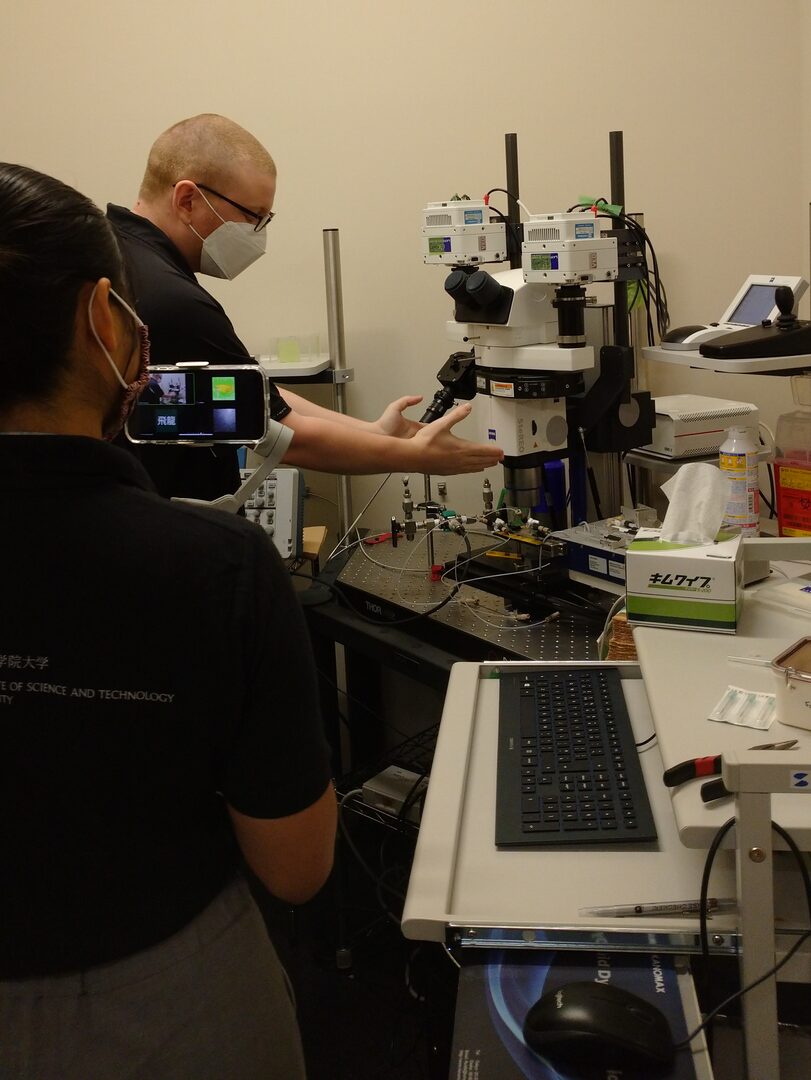
Dr. Cameron Hopkins gave a virtual tour of our lab to Japanese undergraduate students, March 16, 2022.
7.2 Community Outreach Activities
Dr. Shivani Sathish (OIST POC Fellow) organized and led food drive initiatives through POWER Club at OIST dedicated to the local community. All received donations were delivered to 2 non-profit organizations: HelpOki (June 10th-11th) and Onna Village Council of Social Welfare (November, 2021).

A) Menstrual Care products drive dedicated to HelpOki NPO, Aug 18-20, 2021
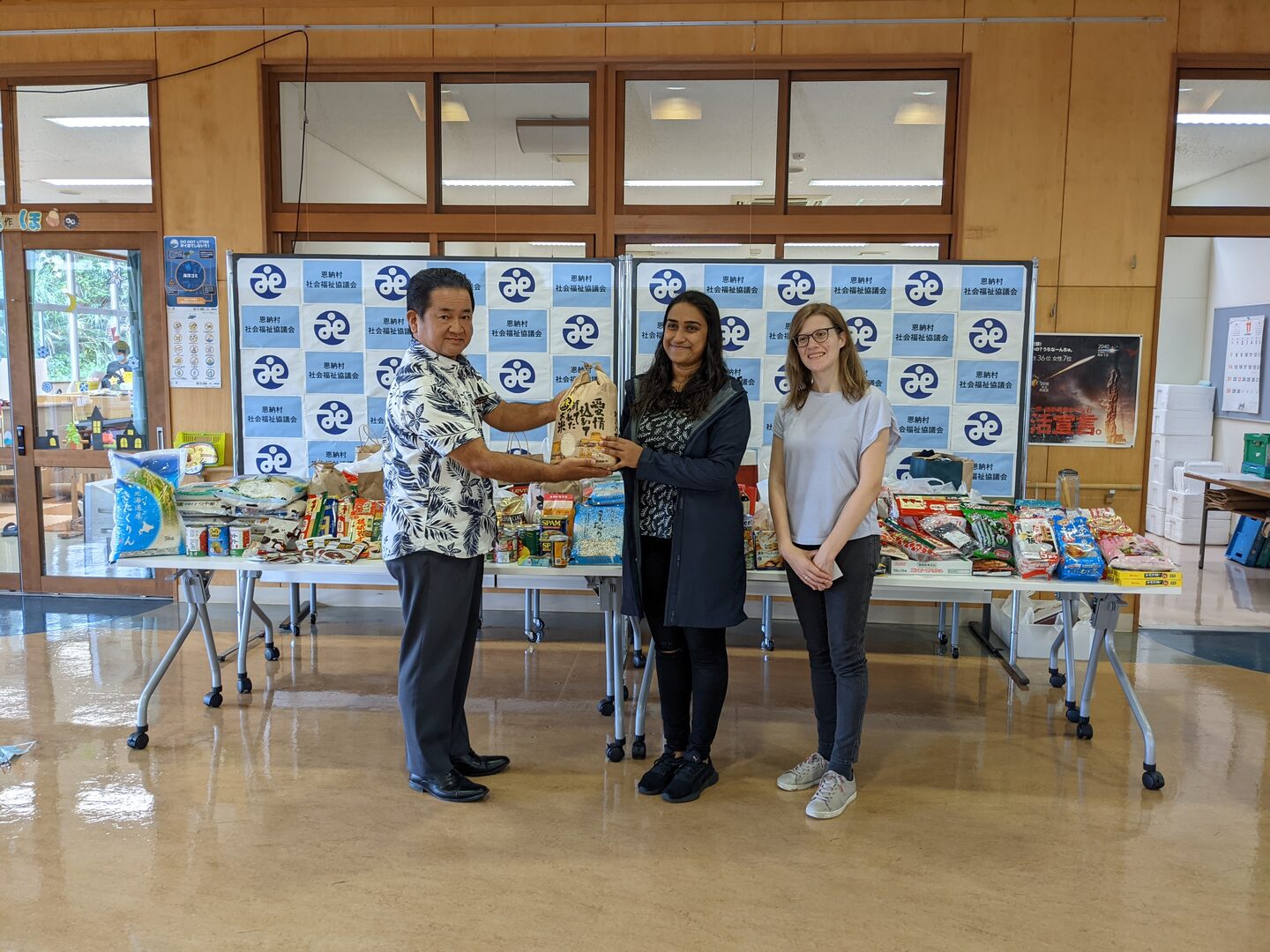
B) Food Drive dedicated to Onna Village Council of Social Welfare, Nov 15-19, 2021.




